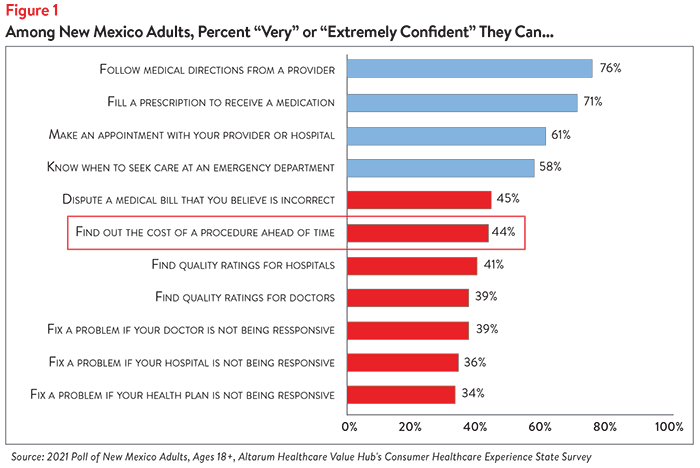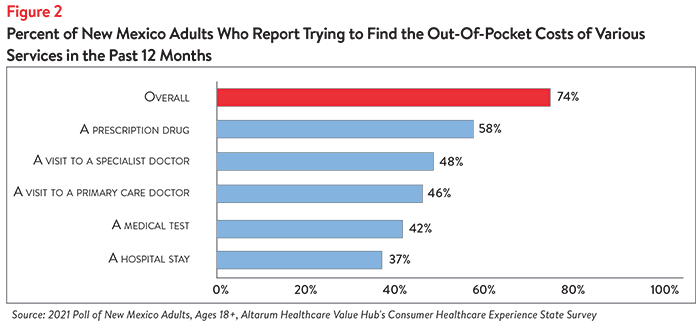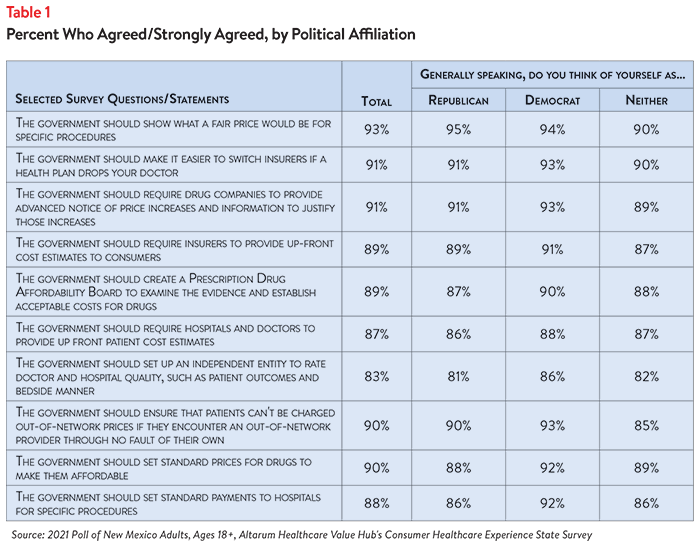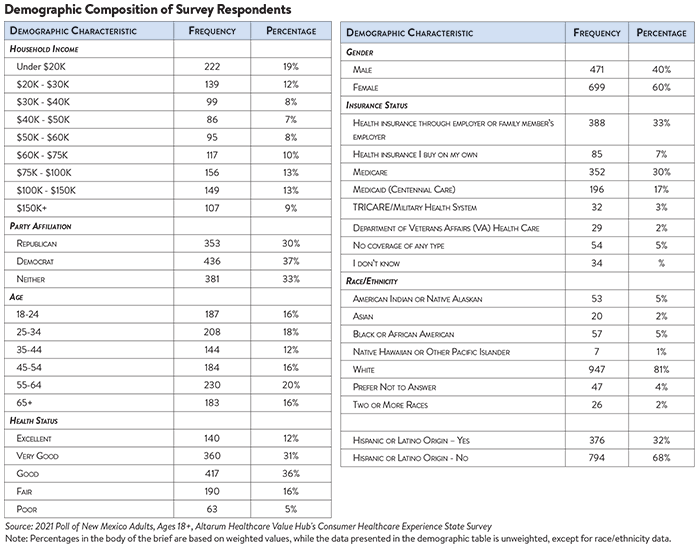New Mexico Residents Lack Confidence in Estimating the Cost and Quality of Care; Express Bipartisan Support for Government Action
A survey of 1,170 New Mexico adults, conducted from July 16, 2021 to August 11, 2021, designed to elicit respondents’ unbiased views on a wide range of health system issues explored residents’ opinions about healthcare price and quality information.1 This data brief presents findings on New Mexico residents’ ability to navigate price and quality information, views on the tradeoffs between healthcare prices and quality and support for transparency-related policy strategies.
Confidence in and Difficulty Determining the Cost of Care
Roughly 2 in 5 (44%) of New Mexico residents are confident they can find the price of a healthcare service ahead of time (see Figure 1); however, 74% percent of residents report seeking the price of a service in the prior 12 months (see Figure 2). Of those who sought pricing information, more than half (58%) attempted to determine the out-of-pocket cost for a prescription drug. New Mexico adults are least likely to have attempted to determine the price of a hospital stay than for other healthcare services, such as prescription drugs, primary care or specialist appointments and medical tests.2


Fifty-three percent of New Mexico adults who sought prices for a medical service or prescription drug or sought quality information for a doctor or hospital only performed this activity once or twice. Two thirds (67%) of respondents who report seeking prices report doing so in order to compare two or more providers for the same service.3 Eighty percent of these individuals report that they were successful (see Figure 3).
Relationship Between Quality and Price
In light of well-documented, widespread variation in clinical quality and price,4 it is clear that consumers need both price and quality information to successfully identify providers and treatment options that are of “good value” (within a limited assortment of “shoppable” procedures). Researchers have established that failing to provide quality data alongside price information may result in consumers using price as a proxy for quality,5 despite little evidence of a relationship between the two.6
While almost two-thirds (63%) of New Mexico adults believe that higher quality healthcare usually comes at a higher cost, very few believe that prices reliably signal the quality of care. Just 30% believe that a less expensive doctor is likely providing lower quality care (see Figure 4).

Both cost and quality are important to New Mexico healthcare consumers. Almost half (47%) believe that, if two healthcare providers had equal quality ratings, out-of-pocket costs would be a very or extremely important factor in deciding between the two professionals. Conversely, 51% believe that, if out-of-pocket costs were equal, quality ratings would be a very or extremely important factor in deciding between the two professionals.
New Mexico adults do attempt to find quality data on providers and hospitals, but confidence in their ability to do so is low. Just 39% of New Mexicans are confident that they can find quality ratings for doctors, while 41% are confident they can find quality ratings for hospitals. However, many still attempt to find this information. Forty-nine percent of respondents report trying to find quality information for a doctor in the past 12 months, although only a third (32%) report being successful. Similarly, 44% of New Mexicans sought quality information for a hospital, but just 26% were successful.
Support for “Fixes” Across Party Lines
When it comes to tackling problems in the health system, respondents endorsed a number of transparency-oriented strategies:7
- 93%—Show what a fair price would be for specific procedures
- 91%—Make it easy to switch insurers if a health plan drops your doctor
- 91%—Require drug companies to provide advanced notice of price increases and information to justify those increases
- 89%—Require insurers to provide up-front cost estimates to consumers
- 89%—Create a Prescription Drug Affordability Board to examine the evidence and establish acceptable costs for drugs
- 87%—Require hospitals and doctors to provide up-front cost estimates to consumers
- 83%—Set up an independent entity to rate doctor and hospital quality, such as patient outcomes and bedside manner
Strikingly, respondents strongly endorsed these approaches across party lines (see Table 1).

While New Mexico residents are united in strongly calling for a role for government in addressing health system issues, they also see a role for themselves. Interestingly, out of ten possible personal actions they could take to address healthcare affordability, only 23% of respondents view “doing more to compare cost and quality before getting services” as effective. This ranked fifty, behind other personal actions, such as:
- 66%—taking better care of my personal health
- 40%—researching treatments myself before going to the doctor8
- 38%—writing or calling my STATE representative asking them to take action on high healthcare prices and lack of affordable coverage options
Conclusion
Price transparency is instrumental to keeping consumers safe by allowing them to judge affordability and plan for the expense of needed healthcare services. It also enables state policymakers to address unwarranted price variation and, in some cases, can incentivize high-cost providers to lower their prices to align more closely with industry rates.
Despite its merits, price transparency is also inappropriately credited for its ability to make markets more efficient. Most notably, transparency tools have generally not been successful when it comes to incentivizing consumers to compare services and shop for the best price.9 This failure stems from tools that don’t contain the types of actionable information consumers need and from the fact that some consumers don’t view healthcare as a shoppable commodity. In fact, many healthcare services are not shoppable, such as those provided in emergency situations and settings that lack a selection of treatments/providers.10 Additionally, price may not the most important factor in healthcare decisions. For example, many patients defer to the courses of treatment their doctors recommend. Other reasons consumers discount price from their healthcare decisions include a preference for the perceived “best care,” regardless of expense; inexperience or discomfort with making trade-offs between health and money; and a lack of interest in or familiarity with costs borne by insurers and society as a whole.
New Mexico residents demonstrate they are knowledgeable about the lack of relationship between the cost and quality of healthcare services and are willing to seek out price and quality information. Respondents report lacking confidence in their ability to find healthcare price information, however many of those who try report finding the information they need. Fewer are successful when it comes to finding information on the quality of the healthcare services they plan to receive.
Additionally, most residents do not believe that comparing cost and quality across providers is a meaningful strategy to make healthcare more affordable. Although 26% report a willingness to take this action, a greater number (38%) indicated a willingness to contact their state representative asking them to take action on high healthcare prices and lack of affordable coverage options.
Respondents strongly endorse a range of policy fixes that elected officials could pursue, both transparency- and non-transparency-related. Policymakers should note, however, that pursuit of transparency initiatives alone is unlikely to move the healthcare affordability needle. Efforts to improve transparency should be paired with other strategies that lower the unit prices of healthcare services, reduce the provision of low-value care and expand coverage options with adequate cost-sharing provisions.
Notes
1. Please see: New Mexico Residents Struggle to Afford High Healthcare Costs; Worry About Affording Future Care; Support a Range of Government Solutions Across Party Lines, Healthcare Value Hub, Data Brief No. 108 (November 2021).
2. This survey was conducted six months after the Centers for Medicare and Medicaid Services’ rule requiring hospitals to publicly display all standard charges for all items and services, as well as shoppable services, in a consumer-friendly format went into effect. While survey respondents may be reflecting on their experiences before the rule went into effect, the well-documented low compliance from large hospitals indicates that the rule has yet to demonstrate the desired effect. See: Kurani, Nisha, et al., Early Results from Federal Price Transparency Rule Show Difficulty in Estimating the Cost of Care, Kaiser Family Foundation (April 9, 2021). See also: Henderson, Morgan, and Morgane C. Mouslim, “Low Compliance from Big Hospitals on CMS’s Hospital Price Transparency Rule,” Health Affairs Blog (March 16, 2021).
3. Nationally, just 20 percent of Americans have tried to compare prices across multiple providers before getting care. See: Still Searching: How People Use Health Care Price Information in the United States, Public Agenda (April 6, 2017). This survey shows that 14% of the total survey respondents in New Mexico have taken this action.
4. Cooper, Zack, et al., The Price Ain’t Right? Hospital Prices and Health Spending on the Privately Insured, Health Care Pricing Project (May 2015). http://www.healthcarepricingproject.org/papers/paper-1
5. Hibbard, Judith H., et al., “An Experiment Shows That A Well-Designed Report On Costs And Quality Can Help Consumers Choose High-Value Health Care,” Health Affairs (March 2012).
6. Hussey, Peter, Samuel Wertheimer and Ateev Mehrotra, “The Association Between Health Care Quality and Cost: A Systematic Review,” Annals of Internal Medicine (Jan. 1, 2013).
7. Worth noting, respondents also endorse a range of strategies beyond the transparency approaches included here. For other strategies, please see: New Mexico Residents Struggle to Afford High Healthcare Costs; Worry About Affording Future Care; Support a Range of Government Solutions Across Party Lines, Healthcare Value Hub, Data Brief No. 108 (November 2021).
8. While “researching treatments myself before going to the doctor” may appear similar to “doing more to compare cost and quality before getting services,” New Mexico residents interpret the two quite differently, as demonstrated by the almost 20 percentage point difference in respondents who selected each action. For example, researching treatments before going to the doctor may involve assessing the risks and benefits of medications or procedures, not necessarily comparing the cost or quality of providers offering a similar service.
9. Revealing the Truth about Healthcare Price Transparency, Healthcare Value Hub, Research Brief No. 27 (June 2018).
10. Researchers at RAND and the Health Care Cost Institute (HCCI) have identified a limited set of healthcare services that are potentially shoppable in advance. See: Frost, Amanda, David Newman and Lynn Quincy, “Health Care Consumerism: Can the Tail Wag the Dog?” Health Affairs (March 2, 2016).
Methodology
Altarum’s Consumer Healthcare Experience State Survey (CHESS) is designed to elicit respondents’ unbiased views on a wide range of health system issues, including confidence using the health system, financial burden and views on fixes that might be needed.
The survey used a web panel from Dynata with a demographically balanced sample of approximately 1,250 respondents who live in New Mexico. The survey was conducted in English or Spanish and restricted to adults ages 18 and older. Respondents who finished the survey in less than half the median time were excluded from the final sample, leaving 1,170 cases for analysis. After those exclusions, the demographic composition of respondents was as follows, although not all demographic information has complete response rates:









